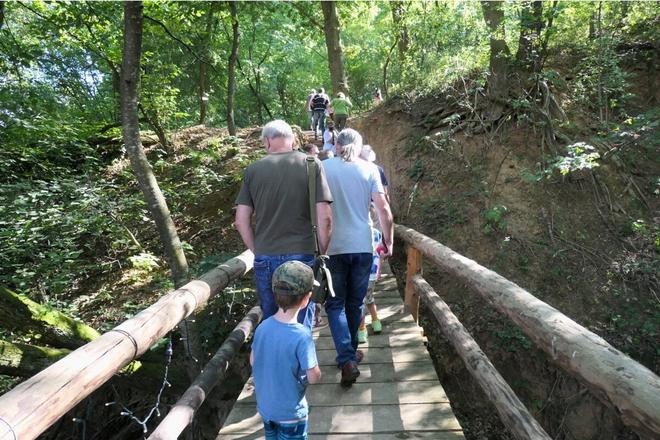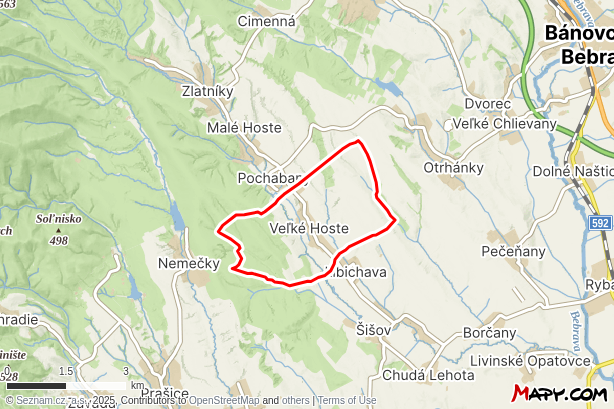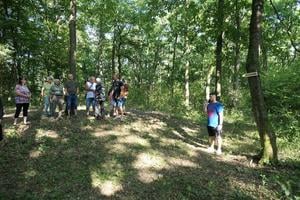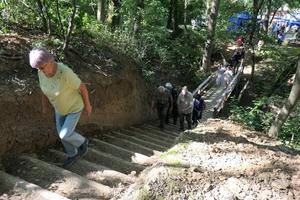For decades, the Chrástky archaeological site in western Slovakia was known mainly to academics and local history buffs. Now, thanks to a newly opened educational trail, it is accessible to anyone with an afternoon to spare.
The short walking path runs through an area where people lived for more than 4,000 years, leaving traces of vanished civilisations. It is set in the village of Veľké Hoste, in the Bánovce nad Bebravou District, and was built entirely by local volunteers, according to My Topoľčany.
The route, called the Mohylník trail, passes burial grounds dating from the Lusatian culture (circa 1300–500 BC) to the Great Moravian period (circa 833–907 AD). The path is gentle enough for children. Brush has been cleared, and information boards explain the site’s history in simple terms.
A carved wooden statue of Saint Gorazd – regarded as Slovakia’s first saint and the successor to the missionary Methodius – stands opposite the largest burial mound, believed to date to around 1200 BC. It was made by local craftsman Ľubomír Bjelko.
A helping hand in the heart of Europe offers a travel guide of Slovakia.
The site also holds more recent memories: an American aircraft crashed here during the Second World War.
Archaeological excavations in the 1950s, led by Jozef Porubský of the Slovak Academy of Sciences, uncovered 80 graves linked to the Lusatian culture. These cremation burials were simple, with ashes placed in pits alongside pottery and small personal items. They offer rare glimpses into daily life, beliefs, and social customs during the Late Bronze and Early Iron Ages.
The most extensive discovery is the Slavic burial ground from the Great Moravian era, with more than 150 small earthen mounds. The varied orientations of the graves suggest Christianity had not yet taken full hold. Many contained jewellery, beads, tools, and weapons. Some of the richest graves held swords, axes, or even a stirrup, hinting that the deceased might have been warriors or mounted nobles.
Historians believe a military garrison once guarded this site, protecting a branch of the Amber Road – an ancient trade route linking Nitra with the Považie region. The name “Chrástky” may stem from the Slavic word chrániť, meaning “to protect”.
Today, the trail offers a rare chance to walk among centuries of history – from Bronze Age burial mounds to the world of early medieval Slavs – all in a quiet corner of the Slovak countryside.
Spectacular Slovakia travel guides
A helping hand in the heart of Europe thanks to our Slovakia travel guide, with more than 1,000 photos and hundreds of tourist spots.
Our detailed travel guide to the Tatras introduces you to the whole region around the Tatra mountains, including attractions on the Polish side.
Lost in Bratislava? That's impossible with our City Guide!
See some selected travel articles, podcasts, traveller info as well as other guides dedicated to Nitra, Trenčín Region, Trnava Region and Žilina Region.


 The Chrástky archaeological site in western Slovakia was known mainly to academics and local history buffs. Now, thanks to a newly opened educational trail, it is accessible to anyone with an afternoon to spare. (source: My Topoľčany)
The Chrástky archaeological site in western Slovakia was known mainly to academics and local history buffs. Now, thanks to a newly opened educational trail, it is accessible to anyone with an afternoon to spare. (source: My Topoľčany)



